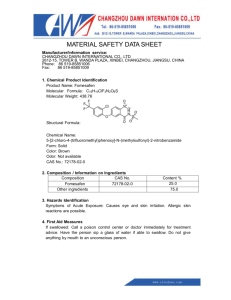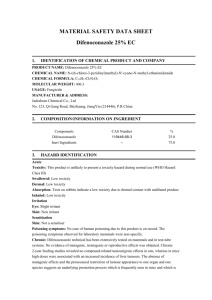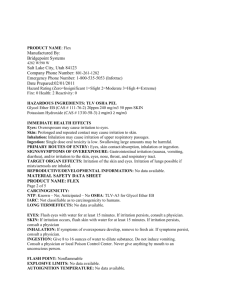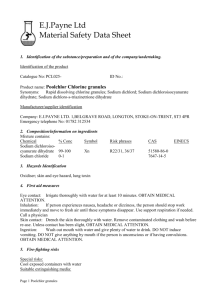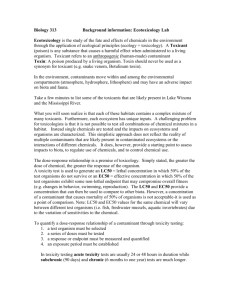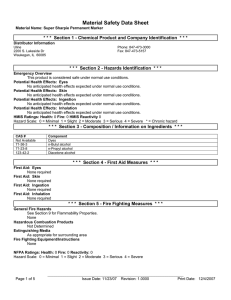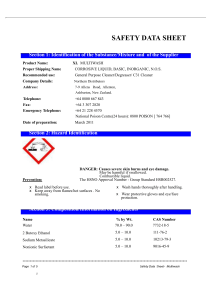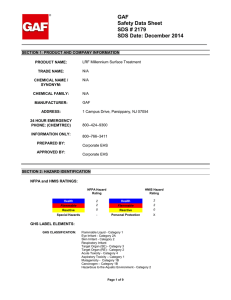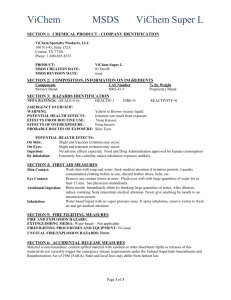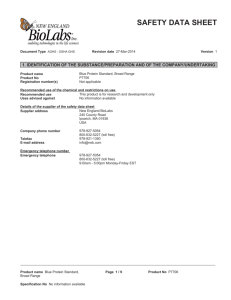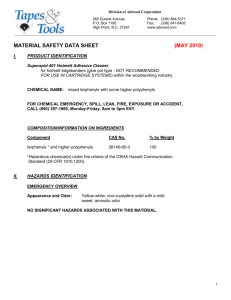poison controls
advertisement
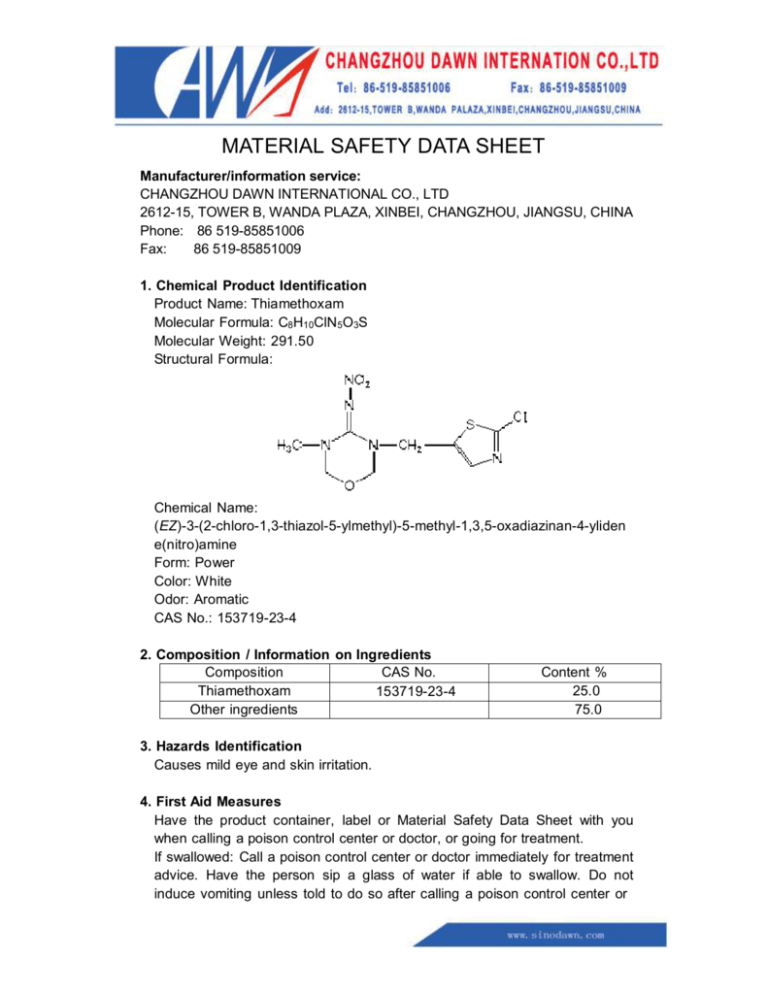
MATERIAL SAFETY DATA SHEET Manufacturer/information service: CHANGZHOU DAWN INTERNATIONAL CO., LTD 2612-15, TOWER B, WANDA PLAZA, XINBEI, CHANGZHOU, JIANGSU, CHINA Phone: 86 519-85851006 Fax: 86 519-85851009 1. Chemical Product Identification Product Name: Thiamethoxam Molecular Formula: C8H10ClN5O3S Molecular Weight: 291.50 Structural Formula: Chemical Name: (EZ)-3-(2-chloro-1,3-thiazol-5-ylmethyl)-5-methyl-1,3,5-oxadiazinan-4-yliden e(nitro)amine Form: Power Color: White Odor: Aromatic CAS No.: 153719-23-4 2. Composition / Information on Ingredients Composition CAS No. Thiamethoxam 153719-23-4 Other ingredients Content % 25.0 75.0 3. Hazards Identification Causes mild eye and skin irritation. 4. First Aid Measures Have the product container, label or Material Safety Data Sheet with you when calling a poison control center or doctor, or going for treatment. If swallowed: Call a poison control center or doctor immediately for treatment advice. Have the person sip a glass of water if able to swallow. Do not induce vomiting unless told to do so after calling a poison control center or doctor. Do not give anything by mouth to an unconscious person. If in eyes: Hold eye open and rinse slowly and gently with water for 15-20 minutes. Remove contact lenses, if present, after 5 minutes, then continue rinsing eye. Call a poison control center or doctor for treatment advice. Skin Contact: If on skin or clothing: Take off contaminated clothing. Rinse skin immediately with plenty of water for 15-20 minutes. Call a poison control center or doctor for treatment advice. Inhalation: If inhaled: Move person to fresh air. If person is not breathing, call 911 or an ambulance, and then give artificial respiration, preferably mouth-to-mouth if possible. Call a poison control center or doctor for further treatment advice. 5. Fire-Fighting Measures Flash Point (Test Method):208°F Unusual Fire, Explosion and Reactivity Hazards: During a fire, irritating and possibly toxic gases may be generated by thermal decomposition or combustion. In Case of Fire: Use dry chemical, foam or CO2 extinguishing media. Wear full protective clothing and self-contained breathing apparatus. Evacuate nonessential personnel from the area to prevent human exposure to fire, smoke, fumes or products of combustion. Prevent use of contaminated buildings, area, and equipment until decontaminated. Water runoff can cause environmental damage. If water is used to fight fire, dike and collect runoff. 6. Accidental Release Measures In Case of Spill or Leak: Control the spill at its source. Contain the spill to prevent from spreading or contaminating soil or from entering sewage and drainage systems or any body of water. Clean up spills immediately, observing precautions outlined in Section 8. Cover entire spill with absorbing material and place into compatible disposal container. Scrub area with hard water detergent (e.g. commercial products such as Tide, Joy, Spic and Span). Pick up wash liquid with additional absorbent and place into compatible disposal container. Once all material is cleaned up and placed in a disposal container, seal container and arrange for disposition. 7. Handling and Storage Store the material in a well-ventilated, secure area out of reach of children and domestic animals. Do not store food, beverages or tobacco products in the storage area. Prevent eating, drinking, tobacco use, and cosmetic application in areas where there is a potential for exposure to the material. Wash thoroughly with soap and water after handling. 8. Exposure Controls/Personal Protection Ingestion: Prevent eating, drinking, tobacco usage and cosmetic application in areas where there is a potential for exposure to the material. Wash thoroughly with soap and water after handling. Eye Contact: Where eye contact is likely, use chemical splash goggles. Skin Contact: Where contact is likely, wear chemical-resistant (such as nitrile or butyl) gloves, coveralls, socks and chemical-resistant footwear. For overhead exposure, wear chemical-resistant headgear. Inhalation: A respirator is not normally required when handling this substance. Use effective engineering controls to comply with occupational exposure limits. 9. Physical and Chemical Properties Melting Point: 139.1℃ 3 3 Density: 1.57×10 kg/m Vapor pressure: 6.6×10-9 Pa 20°C Solubility: easy soluble in water (4.1g/L) and organic solvents: aceton (48g/L), methanol (13g/L) Boiling Point: Not Available PH: 5 - 7 (1% suspension in water) 10. Stability and Reactivity Stability: Stable under normal use and storage conditions. Hazardous Polymerization: Will not occur. Conditions to Avoid: None known. Materials to Avoid: None known. 11. Toxicological Information Ingestion: Oral (LD50 Rat): > 5,000 mg/kg body weight Dermal: Dermal (LD50 Rabbit): > 2,000 mg/kg body weight Inhalation: Inhalation (LC50 Rat): > 2.67 mg/l air - 4 hours Eye Contact: Minimally Irritating (Rabbit) Skin Contact: Slightly Irritating (Rabbit) Skin Sensitization: Not a Sensitizer (Guinea Pig) 12. Ecological and Ecotoxicological Information Summary of Effects: Practically non-toxic to fish, invertebrates and birds. Highly toxic to bees. Eco-Acute Toxicity: Bees LC50/EC50 0.024 ug/bee Invertebrates (Water Flea) LC50/EC50 > 100 ppm Fish (Trout) LC50/EC50 > 100 ppm Fish (Bluegill) LC50/EC50 > 114 ppm Birds (8-day dietary - Bobwhite Quail) LC50/EC50 > 5,200 ppm Birds (8-day dietary - Mallard Duck) LC50/EC50 > 5,200 ppm Environmental Fate: The information presented here is for the active ingredient, thiamethoxam. Not persistent in soil. Stable in water. Moderate mobility in soil. Floats in water (after 24 h). 13. Disposal Considerations Do not reuse product containers. Dispose of product containers, waste containers, and residues according to local health and environmental regulations. 14. Transport Information Not applicable. 15. Regulatory Information Not applicable. 16. Other Information All information and instructions provided in this Material Safety Data Sheet (MSDS) are based on the current state of scientific and technical knowledge at the date indicated on the present MSDS and are presented in good faith and believed to be correct. This information applies to the product as such. In case of new formulations or mixes, it is necessary to ascertain that a new danger will not appear. It is the responsibility of persons on receipt of this MSDS to ensure that the information contained herein is properly read and understood by all people who may use, handle, dispose or in any way come in contact with the product. If the recipient subsequently produce formulations containing this product, it is the recipients sole responsibility to ensure the transfer of all relevant information from this MSDS to their own MSDS.
